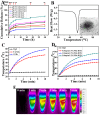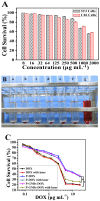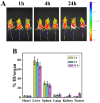Combined cancer photothermal-chemotherapy based on doxorubicin/gold nanorod-loaded polymersomes
- PMID: 25699095
- PMCID: PMC4329499
- DOI: 10.7150/thno.10731
Combined cancer photothermal-chemotherapy based on doxorubicin/gold nanorod-loaded polymersomes
Abstract
Gold nanorods (GNRs) are well known in photothermal therapy based on near-infrared (NIR) laser absorption of the longitudinal plasmon band. Herein, we developed an effective stimulus system -- GNRs and doxorubicin co-loaded polymersomes (P-GNRs-DOX) -- to facilitate co-therapy of photothermal and chemotherapy. DOX can be triggered to release once the polymersomes are corrupted under local hyperthermic condition of GNRs induced by NIR laser irradiation. Also, the cytotoxicity of GNRs caused by the residual cetyltrimethylacmmonium bromide (CTAB) was reduced by shielding the polymersomes. The GNRs-loaded polymersomes (P-GNRs) can be efficiently taken up by the tumor cells. The distribution of the nanomaterial was imaged by IR-820 and quantitatively analyzed by ICP-AES. We studied the ablation of tumor cells in vitro and in vivo, and found that co-therapy offers significantly improved therapeutic efficacy (tumors were eliminated without regrowth.) compared with chemotherapy or photothermal therapy alone. By TUNEL immunofluorescent staining of tumors after NIR laser irradiation, we found that the co-therapy showed more apoptotic tumor cells than the other groups. Furthermore, the toxicity study by pathologic examination of the heart tissues demonstrated a lower systematic toxicity of P-GNRs-DOX than free DOX. Thus, the chemo-photothermal treatment based on polymersomes loaded with DOX and GNRs is a useful strategy for maximizing the therapeutic efficacy and minimizing the dosage-related side effects in the treatment of solid tumors.
Keywords: NIR; chemotherapy.; gold nanorod; photothermal therapy; polymersomes.
Conflict of interest statement
Competing Interests: The authors have declared that no competing interest exists.
Figures












Similar articles
-
Bubble-generating polymersomes loaded with both indocyanine green and doxorubicin for effective chemotherapy combined with photothermal therapy.Acta Biomater. 2018 Jul 15;75:386-397. doi: 10.1016/j.actbio.2018.05.033. Epub 2018 May 21. Acta Biomater. 2018. PMID: 29793073
-
Gold Nanorods-Based Smart Nanoplatforms for Synergic Thermotherapy and Chemotherapy of Tumor Metastasis.ACS Appl Mater Interfaces. 2019 Feb 27;11(8):7800-7811. doi: 10.1021/acsami.8b21784. Epub 2019 Feb 15. ACS Appl Mater Interfaces. 2019. PMID: 30720270
-
Targeting mesoporous silica-encapsulated gold nanorods for chemo-photothermal therapy with near-infrared radiation.Biomaterials. 2013 Apr;34(12):3150-8. doi: 10.1016/j.biomaterials.2013.01.051. Epub 2013 Jan 29. Biomaterials. 2013. PMID: 23369218
-
Photothermal cancer therapy and imaging based on gold nanorods.Ann Biomed Eng. 2012 Feb;40(2):534-46. doi: 10.1007/s10439-011-0388-0. Epub 2011 Sep 2. Ann Biomed Eng. 2012. PMID: 21887589 Review.
-
Preparation of Gold Nanorods and Their Applications in Photothermal Therapy.J Nanosci Nanotechnol. 2015 Jan;15(1):63-73. doi: 10.1166/jnn.2015.9586. J Nanosci Nanotechnol. 2015. PMID: 26328306 Review.
Cited by
-
Gold nanorods together with HSP inhibitor-VER-155008 micelles for colon cancer mild-temperature photothermal therapy.Acta Pharm Sin B. 2018 Jul;8(4):587-601. doi: 10.1016/j.apsb.2018.05.011. Epub 2018 Jun 5. Acta Pharm Sin B. 2018. PMID: 30109183 Free PMC article.
-
Oxygen-generating Hybrid Polymeric Nanoparticles with Encapsulated Doxorubicin and Chlorin e6 for Trimodal Imaging-Guided Combined Chemo-Photodynamic Therapy.Theranostics. 2018 Feb 7;8(6):1558-1574. doi: 10.7150/thno.22989. eCollection 2018. Theranostics. 2018. PMID: 29556341 Free PMC article.
-
Inorganic nanomaterials for chemo/photothermal therapy: a promising horizon on effective cancer treatment.Biophys Rev. 2019 Jun;11(3):335-352. doi: 10.1007/s12551-019-00532-3. Epub 2019 May 17. Biophys Rev. 2019. PMID: 31102198 Free PMC article. Review.
-
Gold nanorods and nanohydroxyapatite hybrid hydrogel for preventing bone tumor recurrence via postoperative photothermal therapy and bone regeneration promotion.Bioact Mater. 2021 Jan 22;6(8):2221-2230. doi: 10.1016/j.bioactmat.2021.01.006. eCollection 2021 Aug. Bioact Mater. 2021. PMID: 33553811 Free PMC article.
-
Review of a new bone tumor therapy strategy based on bifunctional biomaterials.Bone Res. 2021 Mar 16;9(1):18. doi: 10.1038/s41413-021-00139-z. Bone Res. 2021. PMID: 33727543 Free PMC article. Review.
References
-
- Choi W, Kim JY, Kang C. et al. Tumor regression in vivo by photothermal therapy based on gold-nanorod-loaded, functional nanocarriers. ACS Nano. 2011;5:1995–2003. - PubMed
-
- Cole JR, Mirin NA, Knight MW. et al. Photothermal efficiencies of nanoshells and nanorods for clinical therapeutic applications. J Phys Chem C. 2009;113:12090–4.
-
- Helmchen F, Denk W. Deep tissue two-photon micro-scopy. Nat Methods. 2005;2:932–40. - PubMed
-
- Nakamura T, Tamura A, Murotani H. et al. Large payloads of gold nanoparticles into the polyamine network core of stimuli-responsive PEGylayted nanogels for selective and noninvasive cancer photothermal therapy. Nanoscale. 2010;2:739–46. - PubMed
Publication types
MeSH terms
Substances
LinkOut - more resources
Full Text Sources
Other Literature Sources
Miscellaneous

